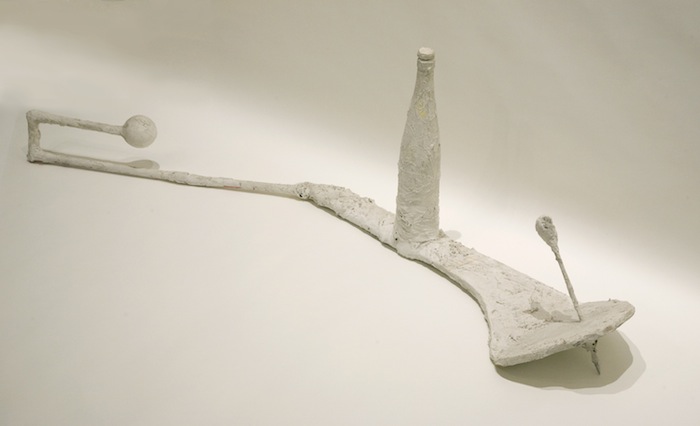Visual Arts Review: Franz West — The Enduring Pleasures of Jaunty Anarchism
At its best, the playful absurdity of Franz West’s work seduces the viewer.
Franz West. At the Williams College Museum of Art, Williamstown, MA, through January 25, 2015. This exhibition is drawn from the Hall Collection and presented in conjunction with the Hall Art Foundation’s installation of West’s monumental outdoor sculpture Les Pommes d’Adam (2007) at MASS MoCA (On view seasonally from May 3 to November 2).
By Anthony Merino
This retrospective exhibition of Franz West (1947-2012) is nothing if not paradoxical: it is dedicated to the ‘art’ of non-art. Including puerile and pornographic images, wallowing in bright garish hues, banishing proportion and elegance, West’s absurdist work sits in the Dadaist tradition of Modernism. Dada pushed the boundaries of what was and was not considered to be art, and the movement heavily influenced artists who would emerge only a few years before West in both his native Austria and the US. What sets West apart is that he is more irrational and humorous than many of his contemporaries, which may make his work more authentically Dada. Of course, this threatens to turn him into a shaky oxymoron; West the orthodox revolutionary. On the one hand, former perceptions of his work as political criticism no longer hold. What was culturally subversive at one point in time often becomes tame later on. On the other hand, what saves West from being old hat is the exhilarating insanity of his work — his brand of tongue-in-cheek derangement still resonates.
In the ’70s, West’s controversial versions of Dada coincided with the efforts of other artists, such as Joseph Beuys and the Vienna Actionists. But there was a telling difference. Both Beuys and the Actionists created works that were earnestly and ardently tawdry. The gore, explicit sexuality, and violence in their pieces was there for a purpose, there was a political intent. West’s dedication to banality — his allegiance to nonchalance and triviality — represented a radical alternative. This departure is most immediately evident in his erotic pieces Nie kommst du Gundl! (1976) and Untitled (1976). The works are determinedly sloppy. Each picture contains figures that are rendered with anatomical inaccuracies and exaggerations. They read less as illustrations of human sexuality than as lazy depictions of how a 13-year-old boy would envision the carnal. This juvenile quality encourages viewers to marginalize the works. The images are too easy to dismiss to be offensive.
Curiously, West’s images of implied sexuality are far more tantalizingly subversive. His collage Behände Bulgarin (1983) includes a photo of a kneeling woman in a suggestive outfit. Her left hand is up in the air; it seems to be grasping an undefined object. West superimposes this image on a rough outline of a wall rendered in red. The photo of a woman on her knees suggests a conventional sexual power dynamic. But the bright red is at the core of the work — the color suggests a number of meanings, from communism to blood. This ambiguity turns the piece into a mirror. Viewers are invited to make sense of the image using their own imaginations and perspectives.
The exhibition includes many three dimensional collages that West referred to as Paßstücke (Adaptives). These pieces reach back in time while reflecting contemporary concerns. In 1936, Swiss artist Méret Oppenheim created Fur Lined Teacup: the artist wrapped a teacup, spoon, and saucer in fur — rendering them unusable. Many artists adapted this template during the ’60s and ’70s. Joseph Beuys’s Felt Suit (1970) and Claus Oldenburg’s Soft Typewriter (1963-1964) alter an ordinary object so that it can no longer function as it was intended. Oppenheim, Beuys, and Oldenburg distort and undermine everyday objects, but they do so rationally and economically. There is a reason behind their deconstruction of the ordinary. West’s impish alterations reject logic. He often incorporates various objects into a sculpture in ways that radically compromise their function. In Refresher (ca. 1982), West mashes together a glass bottle, what looks like an ice pick, and a bent stick with a ball on the end. The structure is pure lunacy.

Franz West, “Refresher,” ca. 1982, wood, glass bottle, steel, gauze, and acrylic paint. Photo: Hall Collection.
At its best, as in Refresher, West’s weird playfulness seduces the viewer. The exhibition includes a number of pieces that generate giggly amusement. The most appealing works in the exhibition pull out all the irrational stops. In Laokoon (2002), West creates a large object out of lacquered aluminum painted bright pink — it looks like a semi-crumpled straw wrapper. Hermo, Kobo, and Prieso (2003) are hanging neon lights on which the artist has stuck nondescript blobs of metal, lacquer, and papier-mâché. If you were so inclined, you could see these mischievous works as being didactic in the spirit of the Actionists. Instead of the latter’s undermining the complacency of bourgeois society with horrific and risqué images, West subverts the normal through his wacky sense of humor.
In truth, the less West’s work is looked at for its messages about society’s decadence the better. In the context of the Cold War, West’s jaunty nihilism came off to some as shocking and subversive. In contemporary America, the artist’s celebration/critique of banality looks tame and stale. In a culture where a restaurant chain is named Hooters and there’s a Jackass movie franchise, sophomoric tastelessness has become the norm. Vulgarity is a profitable marketing niche. Given this context, the enduring power of West’s non-art lies in its joshing anarchism.
Anthony Merino is an unaffiliated artist and critic working out of Adams, Massachusetts. He has published and presented papers on contemporary art internationally. Additional articles are available here.

